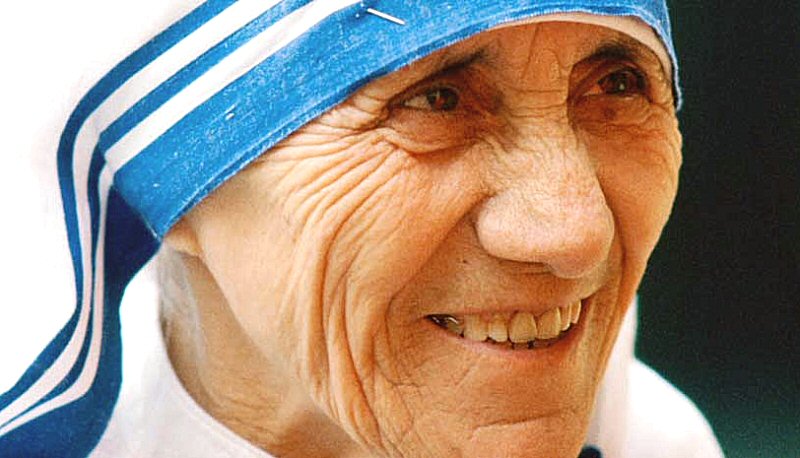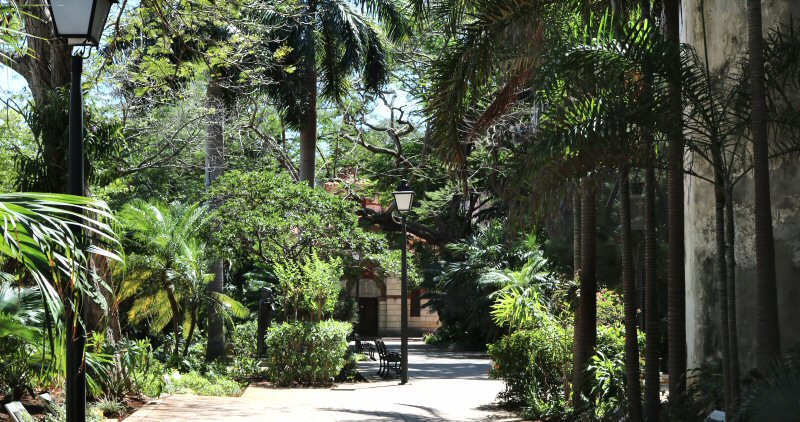
The Jardín Madre Teresa de Calcuta
(Garden of Mother Teresa of Calcuta) that occupies the
entire area on the back of the Basilica Menor de San Francisco de Asís,
was built on the place, where the dome of the mentioned
church was knocked down by a cyclone in 1850. It was
inaugurated in 1999 to pay tribute to the life and the work
of Mother Teresa of Calcuta that was twice in Cuba. In her
first visit she only passed through the airport. Her second
visit took place in 1985.
It is like a park, more than a
garden, where you can rest and take refuge from the sun for
a few minutes. The garden is often overlooked by the
passers-by, as it is surrounded by rough and high stone
walls that hide the condense green vegetation that fills the
area. Sitting on the bench in this wooded oasis just a few
minutes are enough to feel oneself distant from the bustling
square.
At the rear entrance of Basilica
Menor de San Francisco de Asís that looks to the Avenida del
Puerto, there is the bronze sculpture of Mother Teresa of
Calcutta, dressed in her traditional habit, sitting on a
flattened rock and reading a book in a lean position.
The life-size sculpture of Mother
Teresa is the work of the Cuban artist José Villa Soberón
that is particularly known for his public sculptures in
Havana, such as the statues Caballero de Paris (in Plaza de
San Francisco), Ernest Hemingway (in Floridita bar), Che
Guevara (in Palacio Central de Pioneros Ernesto Che Guevara,
Parque Lenin), and John Lennon (in John Lennon Park). The
statue evokes pleasant feelings in the observer.
This beautiful garden is not only
dedicated to Mother Teresa, but it is also the last resting
place of some prominent figures of Cuban culture, such as
Marta Arjona (sculptor and ceramist), Lisandra Otero
(diplomat and journalist), Liborio Noval (photojournalist),
Octavio Cortázar (filmmaker), Juan Vicente Bonachea (painter
and graphic designer), Pepe Rafart (plastic artist), Carmen
Montilla Tinoco (Venezuelan painter), Emilio Roig de Leuchsenring (the historian) and his wife María
Benítez Griado. On both sides of the central promenade of the
garden, there are some simple sepulchers that keep the ashes
of these personalities.
The garden is decorated with
sculptures of Cuban contemporary artists.
At the end of the garden there is
the small and beautiful Sacra Catedral Ortodoxa Griega San
Nicolás de Mira that belongs to the Greek Orthodox Church.
 The
nun and missionary Mother Teresa (original name Agnes Gonxha
Bojaxhiu, born in Skopje, Macedonia in 1910, died in 1997)
devoted her life to caring for the sick and poor. She was
the founder of the Order of the Missionaries of Charity, a
Roman Catholic congregation of women dedicated to help
the poor. Her order established centers for the blind, aged,
disabled and leper people. In 1979 she received the Nobel
Peace Prize for her humanitarian work. In 1980 she was
awarded the Bharat Ratna, India’s highest civilian award. In
2002, the Vatican recognized a miracle involving an Indian
woman, who said that she was cured of an abdominal tumor
through Mother Teresa's intercession in 1998, one year after
the death of Mother Teresa. She was beatified (declared to
have attained the blessedness of heaven and authorized the
title "Blessed") as "Blessed Teresa of Calcutta" by the Pope
John Paul II in 2003. In 2015 Pope Francis issued a decree,
recognizing a second miracle attributed to Mother Teresa.
When a Brazilian man with a viral brain infection lapsed
into coma, his wife, his family and his beloved prayed to
Mother Teresa. The man woke up and was cured of his
symptoms, when he was brought to the operating room. Thus,
Mother Teresa was canonized as a Saint of the Roman Catholic
Church by Pope Francis in 2016.
The
nun and missionary Mother Teresa (original name Agnes Gonxha
Bojaxhiu, born in Skopje, Macedonia in 1910, died in 1997)
devoted her life to caring for the sick and poor. She was
the founder of the Order of the Missionaries of Charity, a
Roman Catholic congregation of women dedicated to help
the poor. Her order established centers for the blind, aged,
disabled and leper people. In 1979 she received the Nobel
Peace Prize for her humanitarian work. In 1980 she was
awarded the Bharat Ratna, India’s highest civilian award. In
2002, the Vatican recognized a miracle involving an Indian
woman, who said that she was cured of an abdominal tumor
through Mother Teresa's intercession in 1998, one year after
the death of Mother Teresa. She was beatified (declared to
have attained the blessedness of heaven and authorized the
title "Blessed") as "Blessed Teresa of Calcutta" by the Pope
John Paul II in 2003. In 2015 Pope Francis issued a decree,
recognizing a second miracle attributed to Mother Teresa.
When a Brazilian man with a viral brain infection lapsed
into coma, his wife, his family and his beloved prayed to
Mother Teresa. The man woke up and was cured of his
symptoms, when he was brought to the operating room. Thus,
Mother Teresa was canonized as a Saint of the Roman Catholic
Church by Pope Francis in 2016.
The Jardín Madre Teresa de Calcuta lies
on the eastern aspect of the Basilica Menor de San Francisco de
Asís in Plaza de San Francisco, located between the convent and
the Avenida del Puerto.
